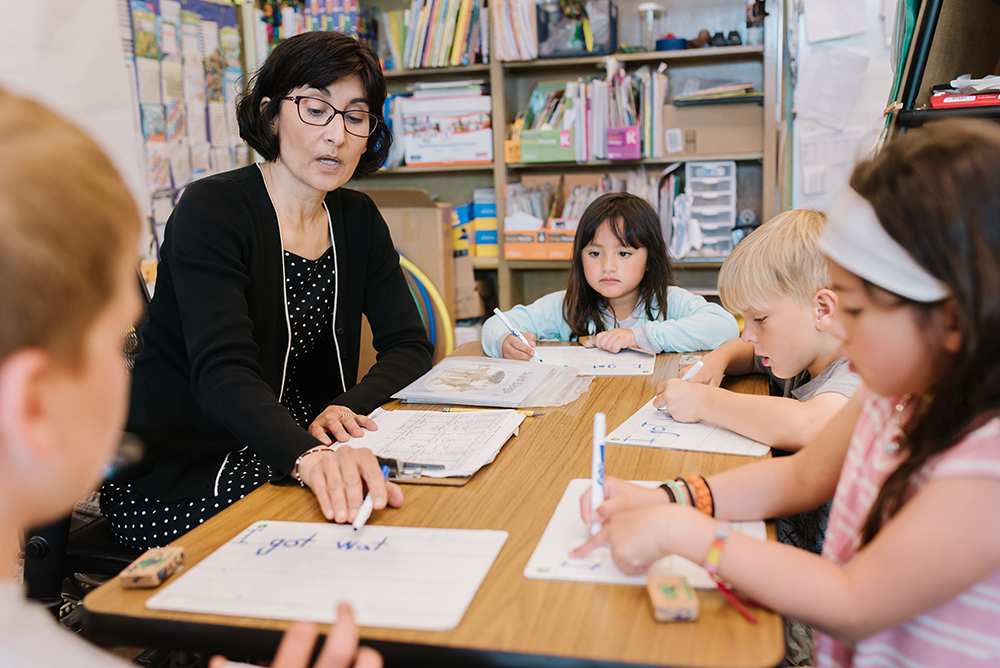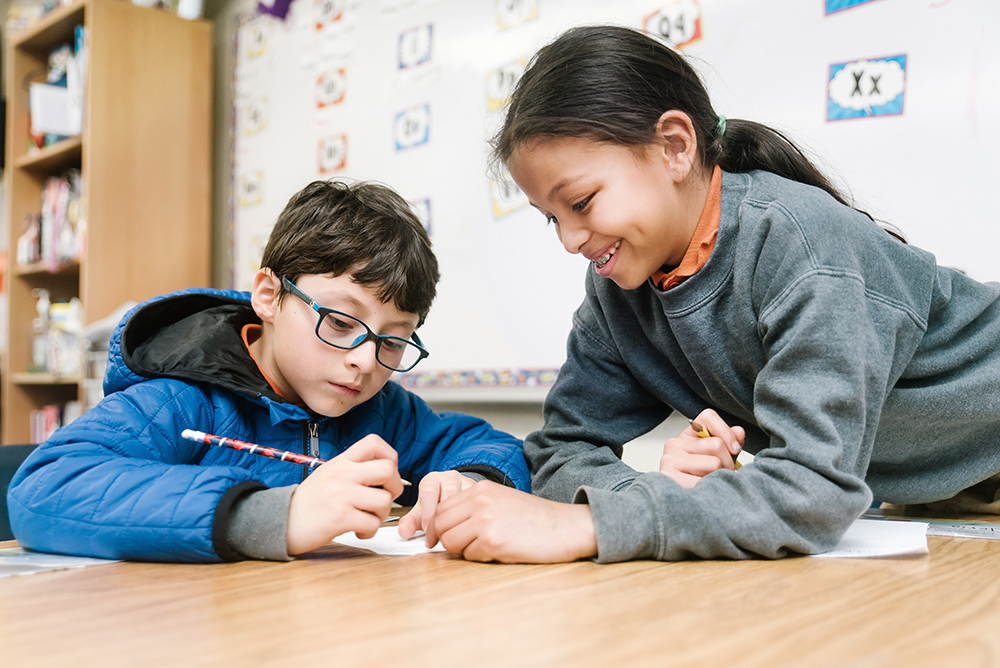“Juliet, I gave you your first set of purple composition notebooks when you turned thirteen. Do you remember what I wrote on your card?”
Reading will make you brilliant.
Writing will make you infinite.
“Juliet, you must write. You will write….. This world is yours to reinvent.
Do you understand?”
This excerpt, from Juliet Takes a Breath by Gabby Rivera, demonstrates the interconnected power of literacy’s twin components, writing and reading. Juliet is encouraged to read and in turn, use writing to become infinite and reinvent the world.
Reciprocal Processes
Reading and writing have long been established as companion learning processes, most commonly referred to as reciprocal (Graham and Herbert, 2011). What does that mean?
“Reciprocal” indicates a symbiotic relationship. This symbiosis in reading and writing is apparent when we realize:
- Reading and writing are born from two naturally occurring language processes: speaking and listening.
- Reading and writing are interconnected. They mutually exchange energy to serve one another.
When it comes to language processes, reciprocity refers to the origin of reading and writing abilities. The human brain is equipped to house and develop centers for speaking and listening. This is not the case for reading and writing. The brain, with the benefit of plasticity, dips into the existing communication centers to begin forging new neural paths for the skills of reading and writing.
The interconnection of reading and writing instruction has several well-established benefits. When both disciplines are equally engaged, space is created for a mutual energy exchange that yields profits in two disciplines instead of one (Graham and Herbert, 2011).

When we learn to decode, we look at written symbols, translate them to their respective sounds, then blend the sounds together and read a word. We repeat the process with a series of words that make a sentence. This is often referred to as lifting words off a page (Norton and Wolf, 2012).
When we learn to encode, we hold words we want to say in our mind, break each of those words into their respective sounds and symbols mentally and then physically construct or write those symbols onto a page. The process is repeated with a series of words that form a sentence or a complete thought. The idea begins in our mind, is disassembled into parts, and reassembled through writing on the page (Norton and Wolf, 2012).
For many learners, the physical task of deconstructing and reconstructing word parts to encode facilitates skill acquisition. As we strengthen encoding skills, an automaticity with word recognition develops that benefits reading fluency, and an increased reading fluency frees cognitive space for greater reading comprehension (Norton and Wolf, 2012).
Learning to read and engage in the work of other writers provides a conceptual understanding of the genres of writing and their design. When students understand the genre on a deeper, conceptual level, taking on the role of writer themselves and composing from scratch becomes less daunting (Graham and Perin, 2007).
Despite the definitive relationship and mutual benefit of these partners, classroom practice has been glaringly slanted towards reading.
Despite the definitive relationship and mutual benefit of these partners, classroom practice has been glaringly slanted towards reading. Why is that, dear reader?
A glimpse into US educational history gives us some answers.
Review of Literacy Initiatives in US History
In 1965, the passage of the Elementary Education and Secondary Education Act (ESEA) brought about three effects:
- First, this law increased the influence of the Federal Government in K–12 education.
- Second, ESEA established Title 1, a program that allocated federal resource dollars to schools in an attempt to level the learning playing field for economically disadvantaged children.
- Most importantly, in 1965, ESEA introduced annual, mandatory standardized testing in all public schools.
In the decades since standardized testing became a part of life in American education, the country has seen dramatic increases in state spending for testing.
Stress levels for both children and adults in schools and districts have risen dramatically with the emphasis of test performance. High stakes = high stress.
Standardized tests have largely been focused on reading, math, and science; consequently, arts and humanities disciplines have been devalued and scarce.
In 1997, the US Congress asked the National Institute of Child Health and Human Development to partner with the Department of Education to establish a National Reading Panel to comb the existing research for evidence-based answers to this pivotal question:
What are the most effective, evidence-based methods for teaching children to read?
In 2000, the commission published their findings in The National Reading Panel Report (Eunice Kennedy Shriver National Institute of Child Health and Human Development, 2000). The crux of this report became known as “The Big Five.”
The panel’s “recipe” for best practice in the teaching of reading had five elements:
- Phonemic Awareness
- Phonics
- Fluency
- Vocabulary
- Comprehension
The Big Five as a recipe for on-grade-level reading success became the focus of classroom teachers, administrators, and test writers everywhere. Nightly news reports spoke about the percentage of third graders in individual states reading on or below grade level.
Research-based reading instruction became the buzzword of the decade.
In 2001, George Bush’s No Child Left Behind (NCLB) Act added some new factors to the national conversation about reading. With NCLB, school funding was tied to performance on standardized testing in reading. In governmental circles, the received wisdom of the day was that the “recipe for success” in reading was now clear, and the next course was to have students demonstrate this success on standardized tests.
US political leaders believed these test scores would discredit the notion that American students were falling behind academically to their peers around the world.
In hindsight, it’s evident that this NCLB push for the most effective, evidence-based reading instruction was flawed.
Our nation, in fact, left one subject behind. It was writing.
Reading and writing are partners. They are interconnected.
Reading and writing are partners. They are interconnected.
Consequences of Leaving Writing Behind
The absence of teaching writing as a craft or process has a myriad of consequences that include life skills, communication, sense making and understanding. Without writing as an equal presence in the literacy classroom, students can suffer from a poignant missed opportunity in both writing and reading.
The obvious consequence is that writing is an important life skill. Along with speaking, writing is a dominant communication option for most humans.
Another point to consider is the importance of writing as a cognitive tool. Writing can be used (in its many forms) to mentally hold on to information too heavy for short term memory’s grasp. In school students are taught to write about something they have read to help deepen their understanding. Many of us use the tool of writing to jot notes in the margins of something we read or when we are making sense of a new text.
Writing is an essential skill for working adults across a wide swath of professions and trades. In the years since our public schools have adopted the “that’s not on the test” mantra, universities and employers have frequently bemoaned the underdeveloped writing skills of their newest students and employees.
In the years since our public schools have adopted the ‘that’s not on the test’ mantra, universities and employers have frequently bemoaned the underdeveloped writing skills of their newest students and employees.
Despite the importance of writing as a skill and the consequences of not developing it, our classroom pedagogy is heavily weighted towards the development of on-grade reading level skills (Graham, 2019).
The art of writing as a process and a craft has become a shadow component of literacy instruction. In some classrooms, this shadowy existence looks like:
“We get to writing whenever we have time.”
Unfortunately, when standardized reading tests are attached to funding dollars and teacher evaluations, time for writing never comes.

Current K–12 classrooms that do regularly include writing instruction often only include the practice of writing in response to reading. Students are instructed to write in response to higher level, evaluative questions about texts. This type of activity is beneficial, as students are required to reread and think deeply, thus strengthening comprehension skills (Brindle, et al., 2016; Graham, 2019).
Research indicates that more often, classrooms omit writing skill instruction. This is despite the established knowledge that reading and writing are interconnected and mutually exchange energy to serve one another. When learners aren’t engaged in being writers themselves, their ability to synthesize and evaluate other authors’ texts is compromised.
When learners aren’t engaged in being writers themselves, their ability to synthesize and evaluate other authors’ texts is compromised.
Without a balance of both reading and writing, students are at risk of not accessing all of their literacy potential. An imbalance of exposure to encoding with a singular focus on decoding may negatively impact growth in both for budding readers and writers.
The Future Must Include Interconnected Literacy Practice
Research has clearly shown us what learners need. Classroom literacy practice is in need of reorganization. Space and practice must be provided for writing to influence reading as much as the converse. The following are specific examples of how this looks in the classroom:
- Focus should be placed on teaching explicitly foundational writing skills to mastery . Attention must be paid to the teaching of foundational writing skills with the same fervor as foundational reading skills (Graham, 2019; Graham and Herbert, 2011).
- Significant evidence exists that writing instruction leads to reading improvement and reading instruction leads to writing improvement. Explicit writing instruction integrated with reading instruction is critical at all grades. Students’ early prewriting attempts carry signals about later decoding, spelling, and reading comprehension performance. Learners who are reading decodable texts with controlled vocabularies should be scaffolded to write similarly (Graham and Herbert, 2011; Graham and Perin, 2007).
- Students at all grade levels need opportunities to write at length often and within a community of fellow writers. Similarly, the modeling of writing by a teacher as fellow writer is an established, rewarding process (Gilbert and Graham, 2010; Graham and Herbert, 2011).
- Students need access to models and exemplars of established writers and genres. Exposure to and instruction around high-quality mentor texts engages students in developing a conceptual understanding. With deep understanding of the framework of a genre, the student is empowered and armed to take on the role of writer (Graham and Perin, 2007).
In the United States, learners are waiting for their schools to provide them with opportunities to be, like the heroine in Juliet Takes a Breath, both brilliant and infinite.
For Further Reading
Deepening the Classroom Writing Community Through Collaborative Writing
Elyse Eidman-Aadahl of the National Writing Project on Writing Instruction
White Paper: What does the research say about powerful writing instruction?
References
Brindle, M., et al. (2016). Third and fourth grade teachers’ classroom practices in writing: A national survey. Reading & Writing: An Interdisciplinary Journal, 29, 929–954. https://doi.org/10.1007/s11145-015-9604-x
Eunice Kennedy Shriver National Institute of Child Health and Human Development, NIH, DHHS. (2000). Report of the National Reading Panel: Teaching Children to Read: Reports of the Subgroups (00–4754). U.S. Government Printing Office.
Gilbert, J. & Graham, S. (2010). Teaching writing to elementary school students in grades 4–6: A national survey. The Elementary School Journal, 110 (4), 494–518. https://doi.org/10.1086/651193
Graham, S. (2019). Changing How Writing Is Taught. Review of Research in Education, 43(1), 277–303. https://doi.org/10.3102/0091732X18821125
Graham, S. & Herbert, M. (2011). Writing to Read: A Meta-Analysis of the Impact of Writing and Writing Instruction on Reading. Harvard Educational Review, 81 (4): 710-744. https://doi.org/10.17763/haer.81.4.t2k0m13756113566
Graham, S. & Perin, D. (2007). Writing Next: Effective Strategies to Improve Writing of Adolescents — A Report to Carnegie Corporation of New York. Alliance for Excellent Education.
Norton, E.S & Wolf, M. (2012). Rapid Automatized Naming (RAN) and Reading Fluency: Implications for Understanding and Treatment of Reading Disabilities. Annual Review of Psychology, 63:1, 427-452. https://doi.org/10.1146/annurev-psych-120710-100431
Rivera, G. (2016). Juliet Takes a Breath. Dial Books, an imprint of Penguin Random House LLC.
